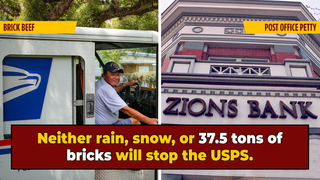When A Businessman Mailed Himself A Whole Bank (Brick By Brick)

Like Wild West pioneers, our Covid-19 isolated asses once again are relying on the postal service to be our link to the outside world, delivering our face masks, birthday presents, and discreet quarantine dildo purchases. And while we should have a heart for all the hard work our beleaguered postal workers are doing, at least we're only expecting them to deliver our daily groceries this time and not the entire grocery store.

In 1916, bank director William Horace Coltharp was in a very relatable shipping cost huff. Tasked with constructing the first bank in Vernal, Utah, he wished to build the exterior out of pressed bricks that could withstand both fires and any leftover prospector dynamite used by old-timey outlaws. But between the closest manufacturers being located in Salt Lake City, the mountainous Vernal having no access to railroads (or even straight roads), and bricks being pretty heavy by design, to privately ship an entire building's worth of materials would have cost an astronomical $2,250 -- roughly $53,000 in today's money. Luckily for Coltharp, a new postal service had just opened in Vernal and, with it, a massive loophole.
Don't Miss
Having started in 1913, the U.S. Postal Service's domestic Parcel Post system was still working out the kinks. A major one, it turned out, was that USPS was calculating shipping cost by distance and not by weight. Worse, these distances were divided into price zones, one of the cheapest being any place within 150 miles as the crow flies. And on the map, Vernal was only 125 miles away from Salt Lake City, never mind the 400 miles of dirt roading it'd take to reach the place by truck. So having done the money math (as bankers are wont to do), Coltharp realized that mailing the bricks would still be twice as cheap as hiring the local Pony Express. So he told the Salt Lake Pressed Brick Company to put all 37.5 tons of bricks in 50-pound crates (the max shipping weight), lick a bunch of stamps and mail the bank through the post office.

Naturally, neither the post office in Salt Lake City nor, especially, in Vernal was equipped to handle such a heavy load. But instead of mailing only a few bricks straight through Coltharp's house windows and calling it a day, the post office did what it always does: power through. Thus began the arduous mission of slowly transporting an entire bank across half a state brick by brick. At a deficit of 21 cents per parcel (which wound up costing the post office $750 in today's money), the Utah postal workers started pulling fifteen-hour workdays to handle the rapid-fire 1,500 parcels, processing about two tons of mail every day.
Safe to say, the postal workers were none too pleased, but by the time the government branch could pass a new 200-pound daily weight limit, their professionalism had already caused all of the heavy parcels to have been delivered -- through that same professionalism didn't prevent the SLC postmaster from referring to Coltharp as a "son of a bitch” in official correspondence. In an act of petty but technically correct revenge (the best kind of revenge), the bureaucrats did refuse to deliver the bricks straight to the bank's construction site, insisting the bankers come to sign for and pick up the heavy parcels at the post office. One by one. All 1,500 of them.

After months of lugging bricks back and forth, the final package was cemented into the exterior or Vernal's new bank. Proving that they were worth the hassle, that same fancy fire-brick façade still furnishes the Zions Bank over a century later. Not that the locals know the bank by that name. They still call it the "Parcel Post Bank" in recognition of who really did the heavy lifting.
For more post-dated postal hacks, do follow Cedric on Twitter.
Top Image: Mick Haupt, Unsplash / A.E. Crane, U.S. National Archives